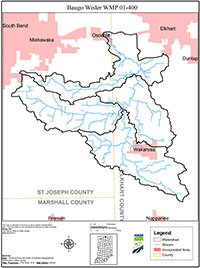Summary
The Baugo Creek Watershed is in the St. Joseph River Sub-Basin (of Lake Michigan). North centrally located in Indiana, it encompasses 49,581 acres - in Elkhart and St. Joseph Counties.
In reviewing available water quality data, it is evident that Baugo Creek and its tributary system have had a history of water quality issues. As early as 1977, the Michiana Area Council of Governments (MACOG) Section 208 Water Quality final report indicated that “In addition, the following observations are made regarding water quality data … Fecal coliform water quality violations in Baugo Creek.” The study further documented Baugo Creek’s historic contamination with bacteria, when it compared fecal coliform in the St. Joseph River and Baugo Creek. The report noted a wet weather sample in the St. Joseph River violating the fecal coliform standard with its recorded value of 500-600 per 100 ml, whereas a violation of 3000 per 100 ml was observed in Baugo Creek. Water quality concerns in the Baugo Creek Watershed have further been chronicled in the Indiana 305b Report, 1986-87, 1988-89 and 1994-95. Each report identifies specifically Baugo Creek as having coliform contamination.
The St. Joseph River Basin Commission conducted a “snapshot” nitrates analysis of the St. Joseph River basin in 1990. Baugo Creek and its major tributaries, Grimes and Rogers ditches, were included in the sampling regime. Of the 20 sites evaluated for nitrates in 1990, Grimes at 9.6 mg/L, Rogers Ditch at 8.5 mg/L and Baugo Creek at 5.8 mg/L, ranked the highest detected levels. A surface water standard for nitrates does not exist, although it is considered a contaminant. Nitrate contamination is associated with fertilizers as well as manure and domestic sewage.
The Indiana one-time standard for Escherichia coli (E. coli) is 235 colonies per 100 milliliters. The geometric mean standard is 125 colonies per 100 milliliters. E. coli is in the intestinal tract of warm-blooded animals and as such is an indicator organism for the presence of sewage or manure contamination. These standards are based on 327 IAC 2-1.5-8(e)(2) for full-body contact recreational use during the recreation season, April 1 through October 31. The rule states:
2. E. coli bacteria, using membrane filter (MF) count, shall not exceed one hundred twenty-five (125) per one hundred (100) milliliters as a geometric mean based on not less than five (5) samples equally spaced over a thirty (30) day period nor exceed two hundred thirty-five (235) per one hundred (100) milliliters in any one (1) sample in a thirty (30) day period.
The IDEM conducted a St. Joseph River basin assessment in 2000. The Baugo Creek Watershed was included in the sampling scheme. The Baugo Creek geometric mean for E. coli was 1,919 colonies per 100 milliliters. As a result of this analysis, Baugo Creek has remained on Indiana’s 303b list of impaired waters, and is scheduled for the eventual development of a Total Maximum Daily Load (TMDL) in the future. A TMDL represents the total maximum load of a substance that can be assimilated by the waterbody and still achieve the water quality standard. During the 2000 assessment, IDEM also assessed the St. Joseph River basin for other water quality parameters. Wisler Ditch, a tributary of Baugo Creek, showed significantly high levels of nitrates as well.
The 2002 Indiana Integrated Water Quality Monitoring and Assessment Report categorized Baugo Creek and its tributaries as “non-supporting” for Primary contact (recreation) and identified Pathogens as a “high” stressor. Baugo Creek and its tributaries was included in the report Final 2002 List of Impaired Waters Under Section 303d of the CWA, published in the Indiana Register, Volume 27, Number 4, January 1, 2004 (pg. 1402).

